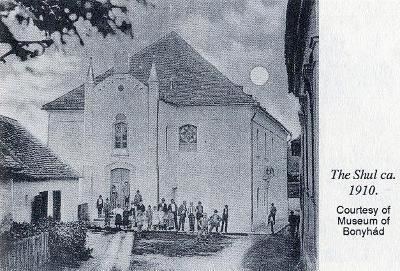Time zone CET (UTC+1) Population 14,093 (2004) Area code 74 | Postal code 7150 Area 72.14 km² Local time Monday 8:42 PM Points of interest Völgységi Múzeum | |
 | ||
Weather 3°C, Wind S at 6 km/h, 96% Humidity | ||
Government
It is governed by a city council and a mayor. The current mayor of Bonyhád is Filóné Ferencz Ibolya who has served in this capacity since 2014.
Bonyhád imagefilm.
Populations
The town's ethnic composition includes Hungarians, Germans, Szekely and Romani. In the years leading to World War II, Bonyhád had a sizable Jewish population. In 1941, Jews constituted approximately 14% of the total population. The community was divided between Orthodox and Neolog Judaism traditions and Aaron Pressburger was the chief Orthodox rabbi.
After the occupation of Hungary by the German army in March 1944, Jews were isolated and their property was confiscated by the Hungarian authorities. In May 1944, the Jewish population was estimated at around 1,300. Between May 12–15, 1944 the Jewish communities of Bonyhád, Bátaszék, Szekszárd and surrounding villages were moved to the two ghettos in Bonyhád. Some Jews were severely tortured to find out where they may have placed valuables. On July 1, 1944 those in the two ghettos were transported by train to the Lakitcs military barracks in the nearby city Pécs and from there deported in horrible conditions to Auschwitz, where most were murdered upon arrival on June 9, 1944 - Tamuz 18, 5704 on the Jewish calendar. Bonyhád was captured on 30 November 1944 by Soviet troops of the 3rd Ukrainian Front in the course of the Budapest Offensive.
After the war a few survivors made an effort to reestablish in Bonyhád the two Jewish communities. After the 1956 revolt most of Bonyhád's Jews escaped from Hungary - mainly to North America and Israel. By 1963 there were only 4 Jewish families left in the town. Bonyhád's last Jewish resident, Mrs. Sári Warum, died in Spring 2013.
Facilities
Bonyhád is home to the Völgység Museum. The town's population is served by a Roman Catholic church and a Lutheran church. The remains of the town's two Synagogues are still visible. There are nine cemerteries, including an Orthodox and the Neologue Jewish cemetery. Various sporting facilities and three high school/college compounds (e.g. Petőfi Sándor Evangélikus Gimnázium, Perczel Mór Szakközépiskola) along with the City Hospital currently serve the residents. Telephone service is provided by Bonicom Kft. Gas service is provided by Futomu Kft and water by Vizmu Reszleg.
Present, economy: Bonyhád in 2016 he received a friendly settlement Investor address. Tolna County, Tamasi and Bonyhád has an address.
Twin towns — Sister cities
Bonyhád is twinned with:
